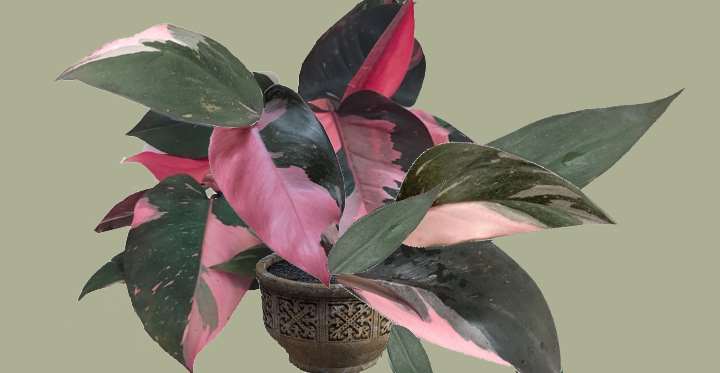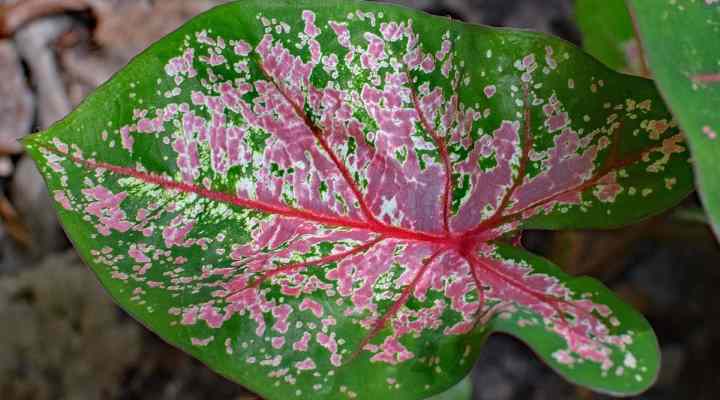Leafy plants with shades of pink ranging from salmon pink, fuchsia, cerise, magenta, to rose pink can add a beautiful tropical touch to any indoor space. They come in various leaf patterns, including striped, speckled, variegated, mottled, or pure pastel pink. Pairing pink-leaved plants with green-leaved plants can create striking color combinations, making them a conversation starter and focal point.
Tropical gardens in hot regions can benefit from the attractive look of pink-leaved plants. Some of the varieties of pink and green plants with striking foliage include Caladiums, arrowhead vines, Ti plants, and begonias. Small pinkish or pink and green leaves are present in certain indoor pink plants like nerve plants, polka dot plants, pink jelly bean plants, and calico kittens.
Succulents can also have foliage in shades of pink, such as pink-colored fleshy leaves or bluish-green leaves with light pink tints. This article showcases some of the most stunning pink houseplants, and for those residing in USDA zones 9 to 11, suitable pink yard plants can also be explored.
Plants with Pink Leaves (Including Pictures)
Pink houseplants come in a variety of leaf colors, including green, white, and pink. Meanwhile, some pink plants have foliage that is exclusively pink and green. In addition, some tropical plants have large leaves that are completely pink. There are various types of pink houseplants that can be grown both indoors and outdoors.
Pink Arrowhead Vine (Syngonium podophyllum)

The ‘Pink Robusta’ and ‘Neon Robusta’ are two varieties of tropical climbing plants called Syngonium that feature dusty pink leaves. These pink Syngonium plants have arrow-shaped leaves that start light pink in color and grow into multi-lobed goosefoot leaves as they mature. The combination of dusty pink and green leaves makes the pink arrowhead Syngonium a popular choice for adding a pop of color to modern interiors, either in a pot or climbing up a moss pole. They can also be grown in a hanging basket where their trailing rosy pink and green leaves create a beautiful vertical effect.
Philodendron Pink Princess (Philodendron erubescens)
The Philodendron Pink Princess (Philodendron erubescens) is a stunning variegated indoor plant with huge pink and green waxy leaves. The thick, leathery leaves have a pink variegation that covers about half of the leaf. Light green patterns may be seen on the large pink patches. In addition, the dark green leaf portion has pink dots.
The Philodendron ‘Pink Congo’ is a kind of philodendron with natural pink variegation that is distinguished by the fact that it has pure pink leaves. However, unlike the ‘Pink Princess,’ which has natural pink variegation, the ‘Philodendron’ bright pink leaves are produced by injecting a chemical to turn the philodendron leaves pink. Pink Congo Philodendrons’ leaves usually return to their original color after six to twelve months of purchase.
Pink-Leaved Caladiums
Caladium plants, belonging to the Caladium genus, are known for their spectacular strap or fancy leaves in pink, green, and white. Some caladium cultivars, also called ‘angel wings’, have vivid pink veins against green, white-spotted foliage. Certain caladium plants display pink leaves with black red veins and green borders. Others feature green leaves with pink and white dots. Dark red or pink patterns are common in caladium plants, and their heart-shaped leaves and vibrant colors have earned them the nickname “heart of Jesus” plant.
One of the caladium cultivars is the sun-tolerant ‘Carolyn Whorton’ (Caladium bicolor ‘Carolyn Whorton’). This variety has large, heart-shaped leaves with pink, red, and green colors. The light-green leaves have crimson veins in the center, surrounded by dark-green edges.
- Caladium ‘Florida Red Ruffles’—The gorgeous ‘Florida Red Ruffles’ feature large arrowhead leaves with dark pink leaves, crimson veins, and green borders with white specks.

- Caladium ‘Strawberry Star’—The big pointed white leaves of the fancy-leaf caladium are green veined and dotted with pink spots.

- Caladium bicolor ‘Thai Beauty’—The intricate pink, green, and white network patterns on this strap-leaf caladium are absolutely stunning.

- Angel Wings ‘White Queen’—White and green caladium leaves with vivid pink to light pink veins.

Pink Aglaonema (Aglaonema costatum)
The leaves of pink aglaonema houseplants are broad and ovate, with pink and green patterns. Bushy foliage and light pink colors make these plants ideal for any home décor. They are also known as Chinese evergreen plants. You may pick from a range of red and pink hues of Aglaonema cultivars and hybrids to match your decoration.
Here are some varieties of pink-leaved aglaonema to consider growing indoors:
- Aglaonema ‘Pink Dalmatian’—The leaves of this pink and green houseplant are glossy green and ovate, with splotches of pink color that resemble drops of paint, as seen in the photos.
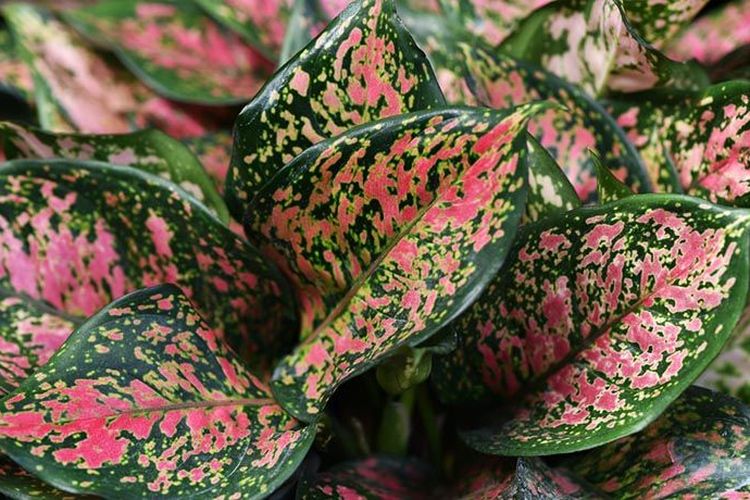
- Aglaonema ‘Super Pink’—The bright pink leaves of the Chinese evergreen are immaculately clean, with green streaks around the edges.

- Aglaonema ‘Pink Splash’ – The leaves of this Aglaonema cultivar are broad and glossy, with pink streaks. The amount of sunlight received by the leaves determines the degree of pink variegation.
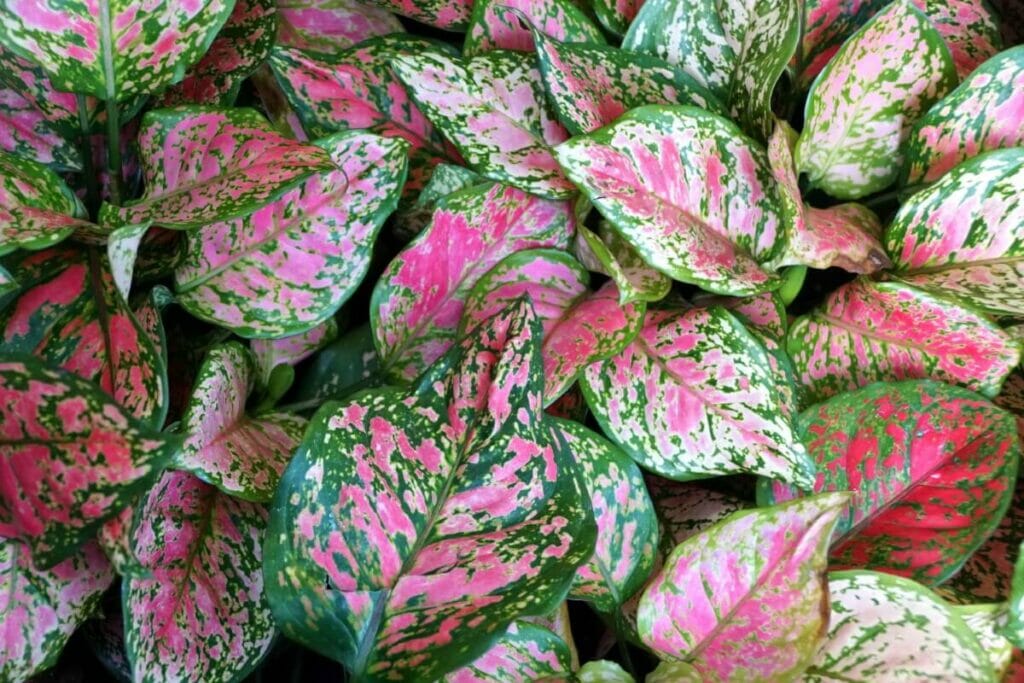
- Aglaonema ‘Two-Tone Moonstone’ – The pink inner ribs and loads of pink speckles adorn the lovely green leaves.
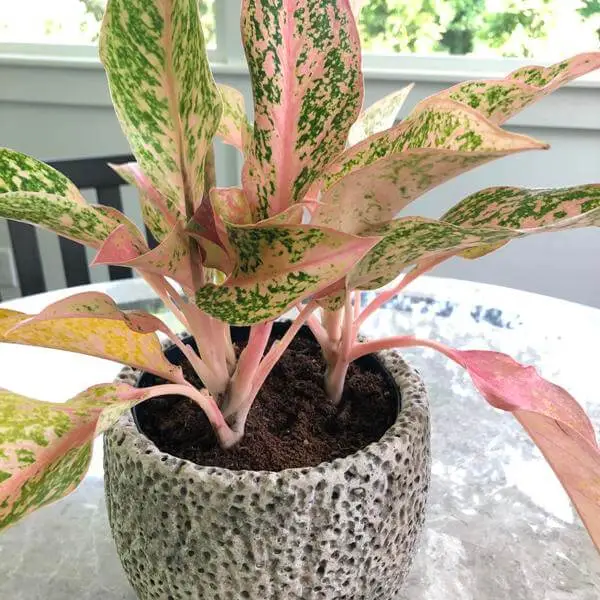
Calico Kitten (Crassula pellucida marginalis Variegata)
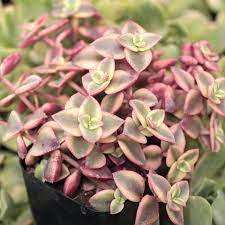
Calico Kitten (Crassula pellucida variegata) is a gorgeous kind of succulent with tiny heart-shaped pink and green leaves. Put a bright windowsill in front of a calico kitten plant to ensure that pink leaves develop. The white and green variegated leaves will blossom pink when exposed to sunlight.
The leaves eventually turn dark crimson. Jade plants are another name for Crassula succulents. Green leaves with pink tinges are found on other types of crassula. Crassula varieties with green and pink leaves are listed below:
- Crassula ovata ‘Hobbit’—Green tubular succulent leaves with pink ends characterize this delicacy.

- Silver jade plant (Crassula arborescens)—This silver jade plant has silvery-gray round leaves with reddish-pink borders, and it bears pink star-shaped blooms when it blooms.
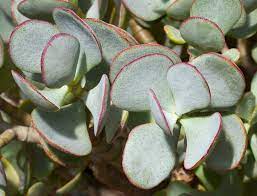
Pink-Leaved Ti Plants (Cordyline spp.)
Ti plants are tropical indoor plants that feature striking vivid pink pointed leaves. These evergreen shrub-like plants have spiky-looking leaves that grow in a rosette pattern. The pink Ti plants vary in leaf shape, with some having strap-like long leaves and others having broad, pointed pink leaves, depending on the species.
Cordyline fruticosa plants produce pink, lavender, or white flowers. There are several Cordyline cultivars that have beautiful pink leaves, including Cordyline ‘Electric Pink.’ This cultivar has maroon-purple long leaves with bold pink stripes, making it a stunning dark pink plant.
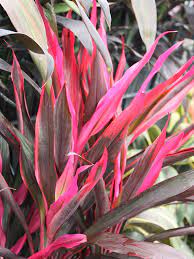
- Cordyline fruticosa ‘Firebrand’—Recognize the huge arching pointed leaves, which are dark pink to dark red in color and grow on bright pink stems.
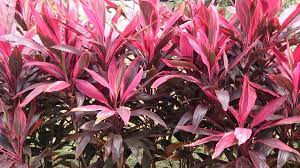
- Cordyline fruticosa ‘Rubra’—Indoor planting of the subtropical Cordyline ‘Rubra’ is advised. The large leaves become a pink russet color, then darken to dark magenta coloration.
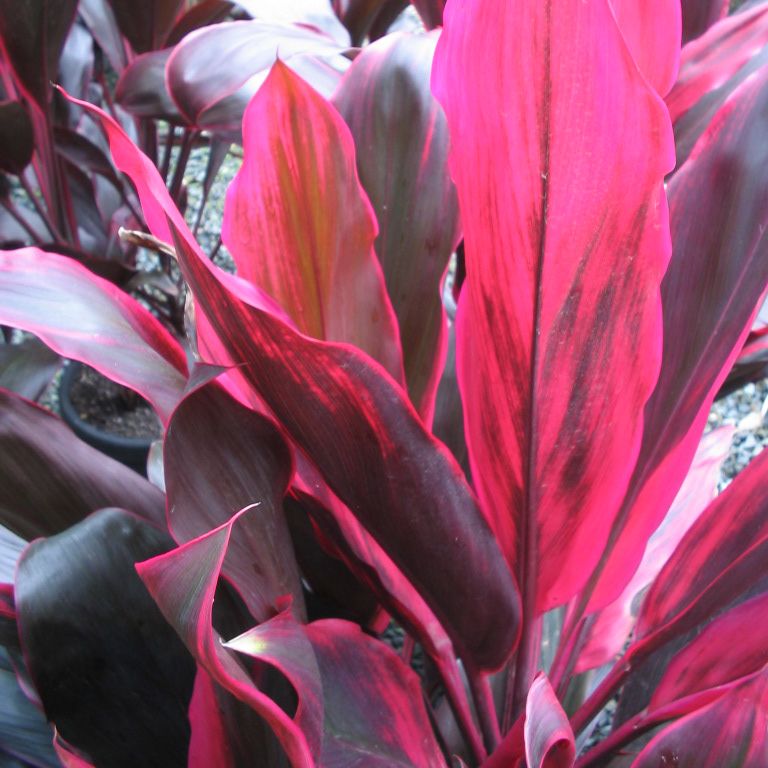
- Cordyline ‘Pink Integrity’ – Pink borders surround the dark oval green leaves.
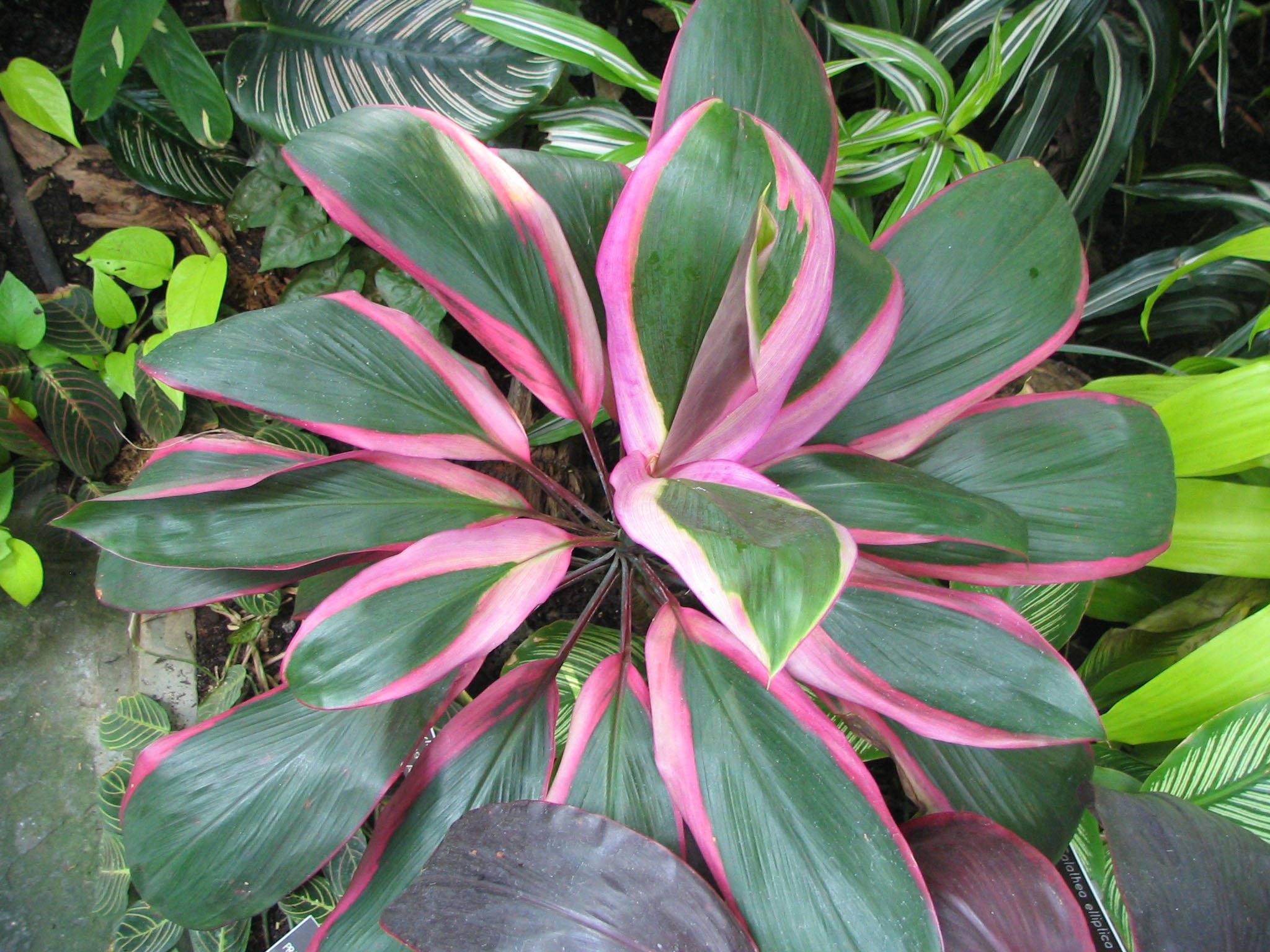
Pink Coleus

Pink coleus plants are popular indoor plants that come in varying shades of pink, orange, yellow, red, and green. They feature ovate leaves with serrated margins. Many coleus cultivars have lime green borders with striking light pink to deep pink centers. One example of a pink coleus plant is the Solenostemon scutellarioides ‘Pink Chaos’, which has thin pink leaves and bright green edges. Pink and green coleus plants are also used as annuals in temperate regions to create borders, container gardens, and hanging baskets with their vibrant foliage. For more information on caring for coleus plants, the Coleus Care Guide is a great resource.
Pink Polka Dot Plant (Hypoestes phyllostachya)

The Hypoestes phyllostachya, also known as the pink polka dot plant, is a beautiful indoor plant with green foliage adorned with light pink streaks. Some varieties of this plant have such intense pink speckles that the oval leaves almost appear entirely pink. Pink polka dot plants are low-maintenance and can thrive as indoor plants in closed terrariums. Here are some lovely varieties of pink polka dot plants:
Pink Splash Plant – This small evergreen plant has dark purple leaves with vibrant pink splashes.

- ‘Pink Splash Select’—The leaves are ovate in shape and have wavy margins. Apart for a green midrib, the leaf is virtually completely pink.

Pink Nerve Plant (Fittonia)
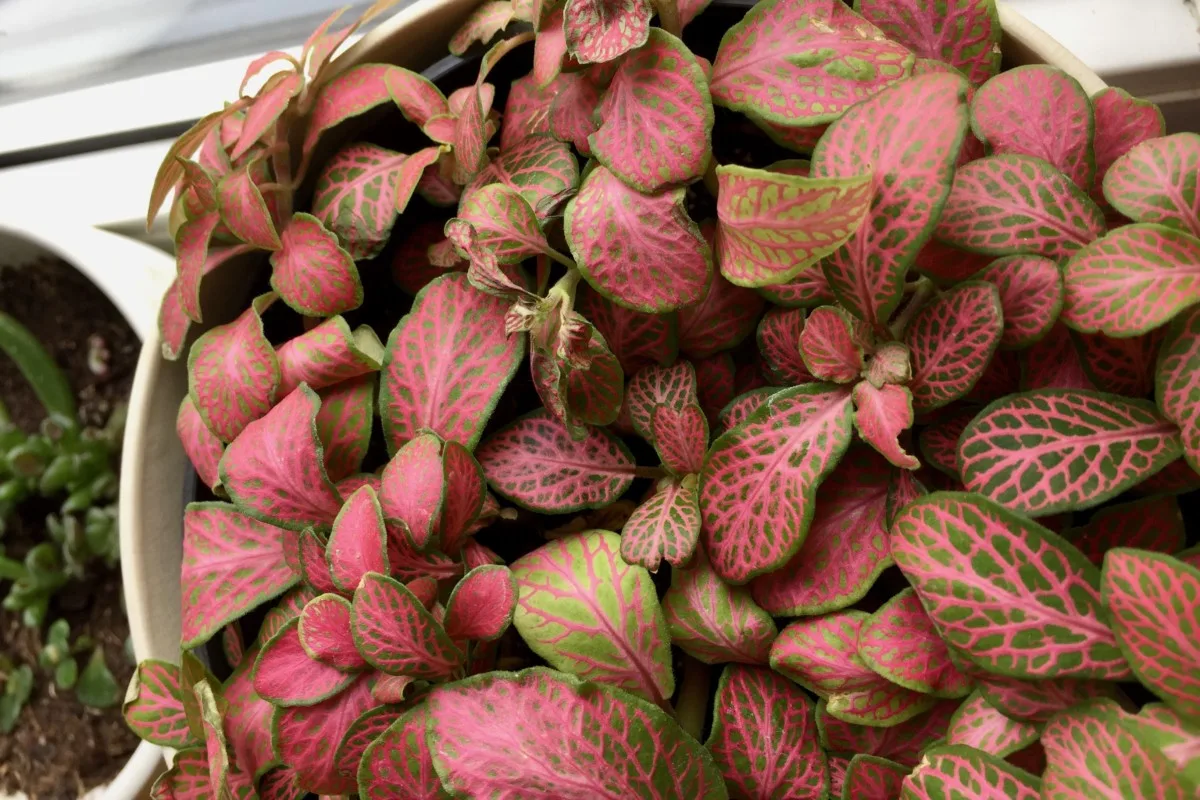
Fittonia ‘Pink Vein’ is a nerve plant that has green leaves with a vein-like pattern in pink, red, or lime green. These indoor plants are compact and easy to grow with exquisite pink mosaic designs on their rich green leaves. Nerve plants are low-maintenance and suitable for terrariums and as houseplants. There are various appealing pink plants with nerve-like or mosaic leaf designs available, such as Fittonia ‘Pink Star,’ ‘Pink Angel,’ ‘Frankie,’ and ‘Pink Vein,’ which has dark pinkish-red veins that make it unique.
Rex Begonias, also known as Begonia rex cultorum, are tropical plants with pink, pointed leaves that make excellent houseplants. These plants come in a variety of colors with heart-shaped leaves in hues of pink, purple, and green. Some rex begonia varieties have crimson undersides to their leaves, making them look more attractive. The lengthy, thickened stems of Rex begonias make lovely hanging basket plants that are suitable for containers. Additionally, pink rex begonias can be grown outside in USDA zones 10 through 12 during summer or year. Rex begonia ‘Red Tango’ is an example of a plant with silvery green and pink patterning in the centre of its heart-shaped leaves and serrated black borders, making it an attractive addition to any garden or home.
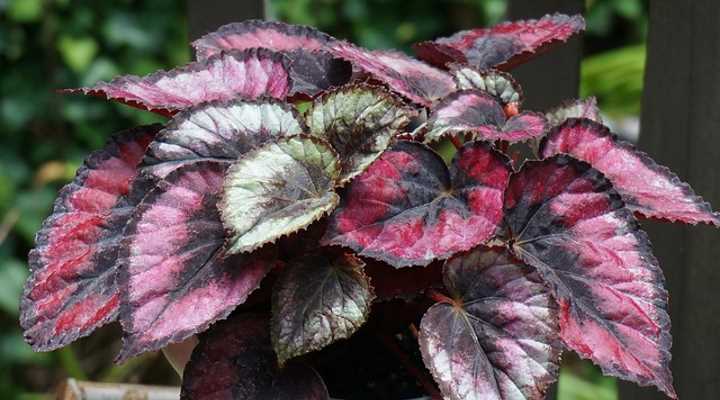
Rex begonia ‘Zurich’—The dramatic dark brown jaggy-looking pattern in the center of the eye-catching begonia leaves is reddish-pink and green.
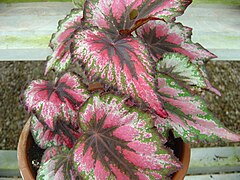
Rex begonia ‘Paul Gibory’—The rex begonia has pink, dark purple, and white patterns on its green leaves.
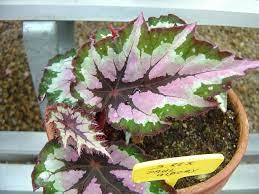
Earth Star (Cryptanthus ‘Pink Star’)
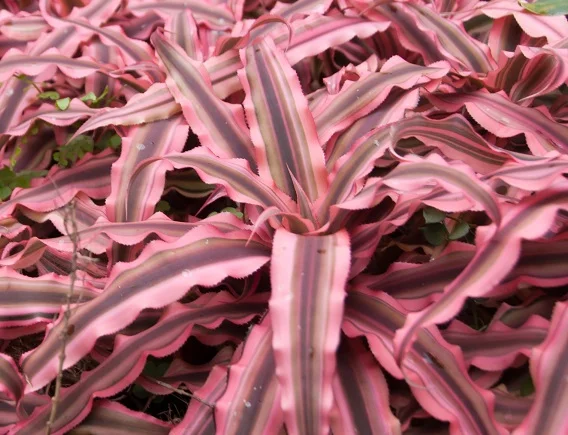
The earth star plant is a short bromeliad with narrow, pink-striped leaves that come to a point. It is named after the planet Earth due to the rosette pattern formed by its vibrant pink leaves. The leaves have wavy edges with small sprigs and can grow up to 2 feet (0.6 meters) broad but do not grow very tall. This tropical plant is not tolerant of cold temperatures and should be grown indoors. Like other bromeliads, the mother plant of the earth star dies after blooming. However, by collecting the pups and planting them in soil, you can increase the number of earth star plants.
Echeveria ‘Perle von Nurnberg’
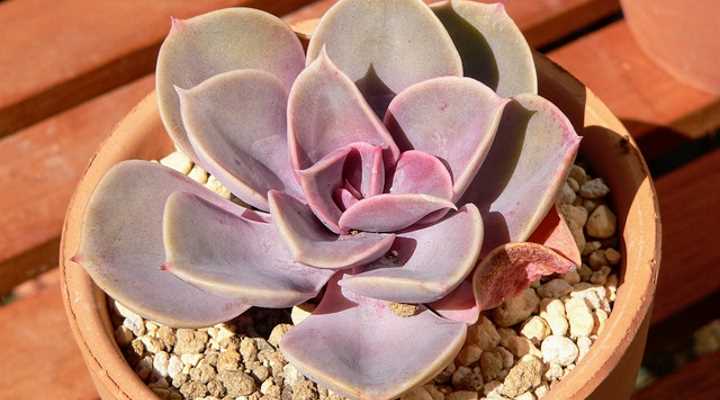
Echeveria ‘Perle von Nurnberg’ is a popular succulent plant that has rose-shaped leaves with pink-purple colors. This plant is highly favored by succulent enthusiasts due to its unique appearance. In low-light conditions, the succulent has a grayish hue, but when exposed to full sunlight, its leaf-like stems turn pinkish-purple in color. During summer, this plant blooms with delicate pink flowers. To ensure healthy growth, it is important to keep the Echeveria succulent in full sunlight and water it sparingly. Propagating the plant is easy using leaf cuttings.
Rose Painted Calathea (Calathea roseopicta)

Indoor gardeners who love large tropical plants with a unique appearance may enjoy the Rose-Painted Calathea. This cultivar of the Calathea plant has big, dark purple leaves with bright pink or fuchsia brushstrokes along the edges that almost look black. Additionally, like other members of the Calathea family, the underside of the leaves is a deep purple color.
Another option for indoor gardeners is the Pinstripe Calathea (Calathea ornata). This plant has glossy, oblong, lance-shaped leaves in green with pale pink or white stripes. The thin lines run diagonally from the midrib to the edge, creating an attractive pattern.

Pink Jelly Bean (Sedum rubrotinctum ‘Aurora’)
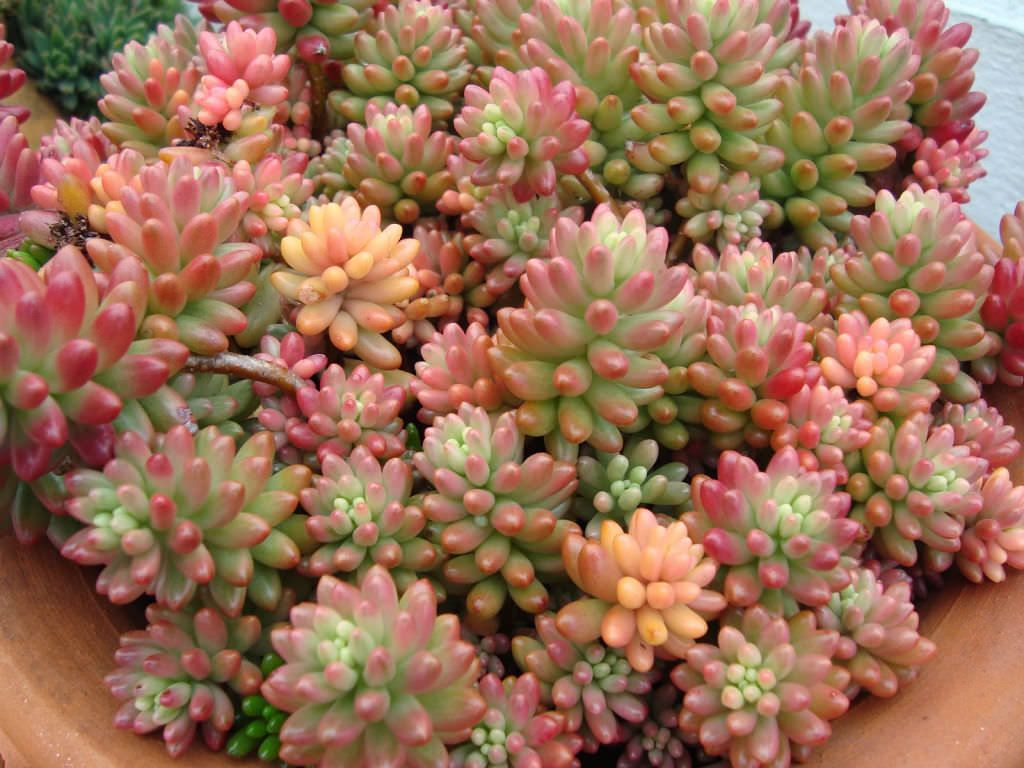
The Sedum rubrotinctum ‘Aurora,’ also known as the Pink Jelly Bean, is an unusual and lovely succulent with pinkish stems and fleshy, spiral-shaped pink leaves. In full sunlight, the pink coloration is even more pronounced, making it a standout in any succulent collection.
Aside from the Pink Jelly Bean, there are other succulent plants with pink foliage, including Sedum versadense. This pink sedum variety is recognized by its raspberry-pink stems and rosette-shaped leaves.

- ‘Sunrise’ succulent (Anacampseros telephiastrum ‘Variegata’)—When the plant is exposed to sunlight, the green leaves turn pink in hue.
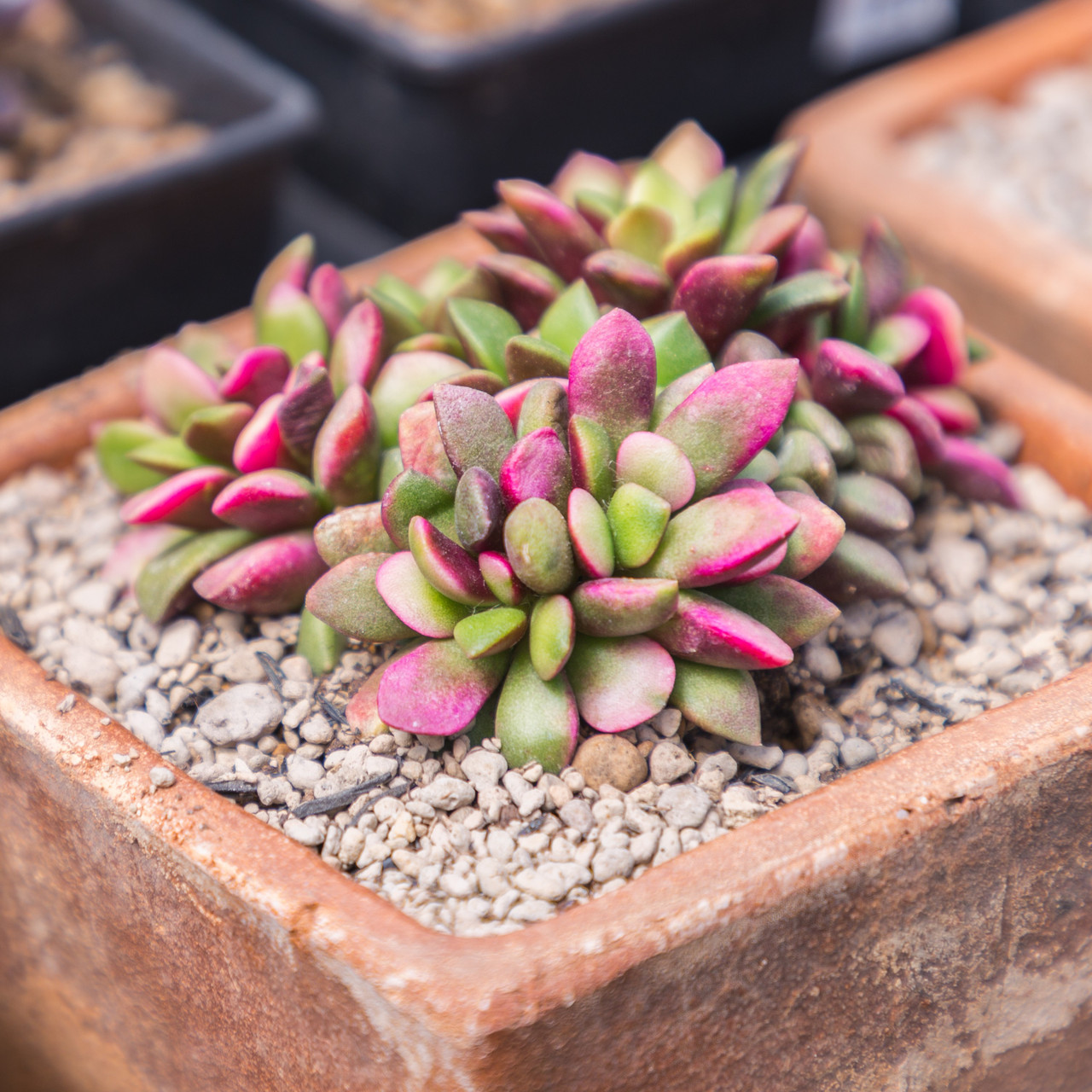
- ‘Moonstone’ succulent (Pachyphytum oviferum)—When growing in the shade, the plump stone-like leaves of this tiny succulent turn a delicate pink.
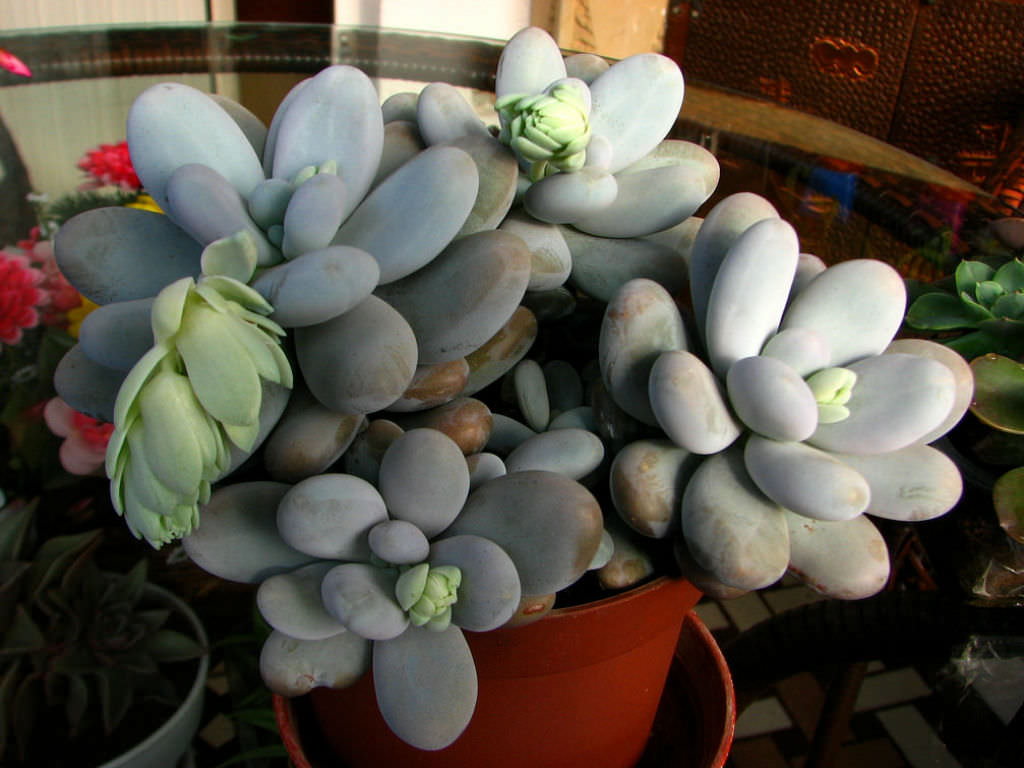
Stromanthe sanguinea
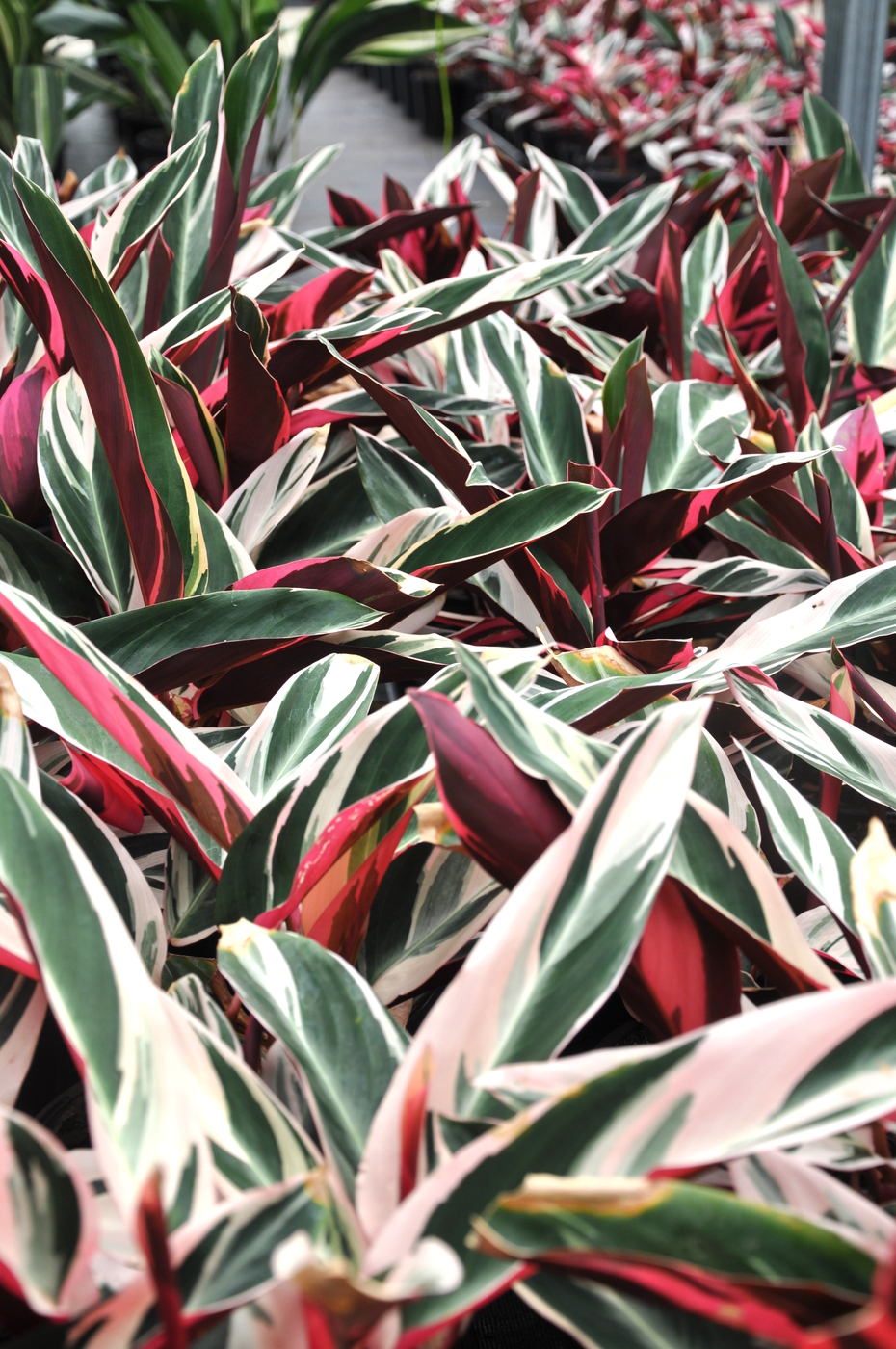
The Stromanthe sanguinea is a large tropical plant with small, long leaves that are green on the upper side and pink-red on the underside. The upper surface of the green leaves features a delicate creamy white fishbone pattern, while the lower surface has a striking half-rolled appearance due to the dark pink undersides. The plant’s reddish-pink stems add to its aesthetic appeal, and it rarely produces blooms.
The Stromanthe sanguinea ‘Tricolor’ is another stunning tropical houseplant with variegated pink and green leaves. The wide, oblong leaves have green and cream-white patterns on the upper surface, with some leaves featuring white variegation and small green areas. The underside of the leaves has pink and dark red coloring that creates a mesmerizing visual effect.

